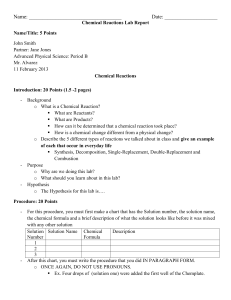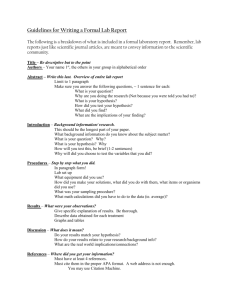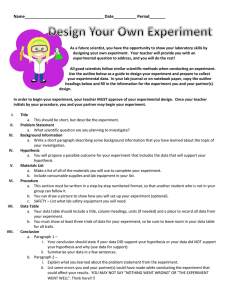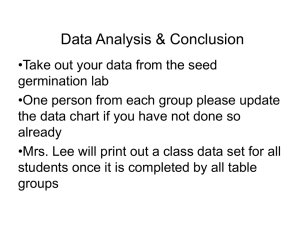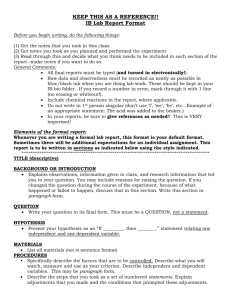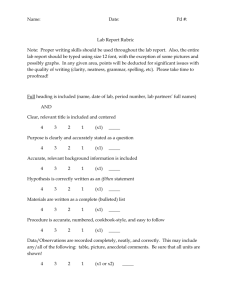Wet lab plant growth - OISE-IS-BIOLOGY-2011-2012
advertisement
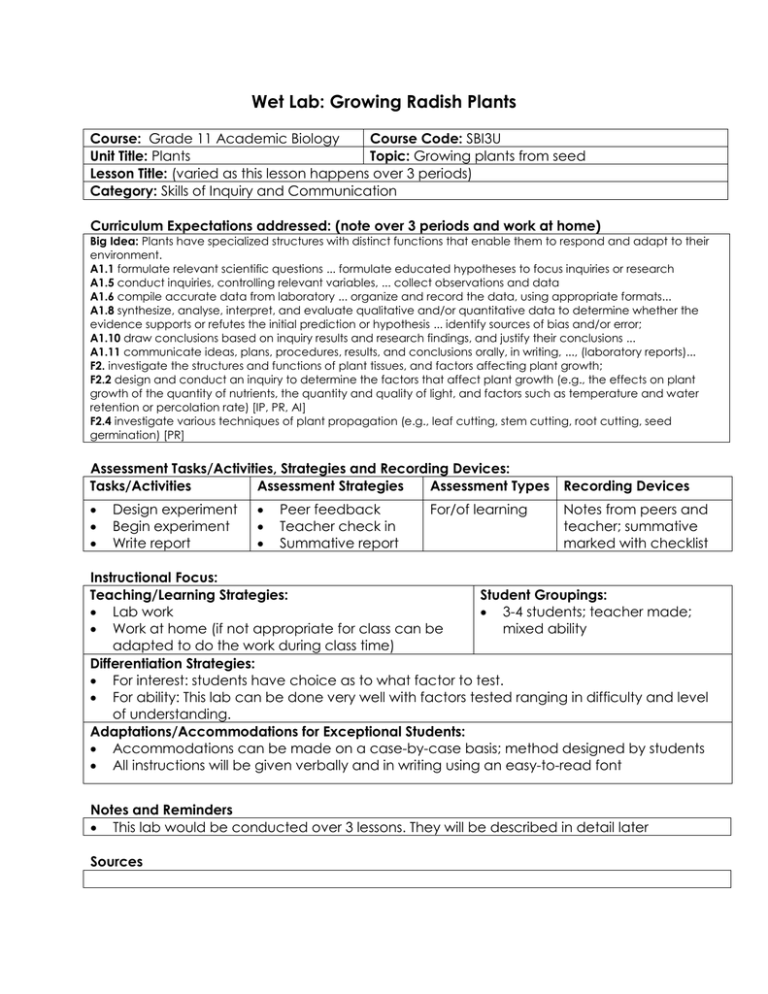
Wet Lab: Growing Radish Plants Course: Grade 11 Academic Biology Course Code: SBI3U Unit Title: Plants Topic: Growing plants from seed Lesson Title: (varied as this lesson happens over 3 periods) Category: Skills of Inquiry and Communication Curriculum Expectations addressed: (note over 3 periods and work at home) Big Idea: Plants have specialized structures with distinct functions that enable them to respond and adapt to their environment. A1.1 formulate relevant scientific questions ... formulate educated hypotheses to focus inquiries or research A1.5 conduct inquiries, controlling relevant variables, ... collect observations and data A1.6 compile accurate data from laboratory ... organize and record the data, using appropriate formats... A1.8 synthesize, analyse, interpret, and evaluate qualitative and/or quantitative data to determine whether the evidence supports or refutes the initial prediction or hypothesis ... identify sources of bias and/or error; A1.10 draw conclusions based on inquiry results and research findings, and justify their conclusions ... A1.11 communicate ideas, plans, procedures, results, and conclusions orally, in writing, ..., (laboratory reports)... F2. investigate the structures and functions of plant tissues, and factors affecting plant growth; F2.2 design and conduct an inquiry to determine the factors that affect plant growth (e.g., the effects on plant growth of the quantity of nutrients, the quantity and quality of light, and factors such as temperature and water retention or percolation rate) [IP, PR, AI] F2.4 investigate various techniques of plant propagation (e.g., leaf cutting, stem cutting, root cutting, seed germination) [PR] Assessment Tasks/Activities, Strategies and Recording Devices: Tasks/Activities Assessment Strategies Assessment Types Design experiment Begin experiment Write report Peer feedback Teacher check in Summative report For/of learning Recording Devices Notes from peers and teacher; summative marked with checklist Instructional Focus: Teaching/Learning Strategies: Student Groupings: Lab work 3-4 students; teacher made; Work at home (if not appropriate for class can be mixed ability adapted to do the work during class time) Differentiation Strategies: For interest: students have choice as to what factor to test. For ability: This lab can be done very well with factors tested ranging in difficulty and level of understanding. Adaptations/Accommodations for Exceptional Students: Accommodations can be made on a case-by-case basis; method designed by students All instructions will be given verbally and in writing using an easy-to-read font Notes and Reminders This lab would be conducted over 3 lessons. They will be described in detail later Sources Overview of the Three Lessons Involved in this Wet Lab: Teacher Notes 1. Introduction of Project/Plant Growth Lab 2. Begin Plant Growth Lab/ Plant Mind Mapping 3. Finish Plant Growth Lab Note: The first 2 lessons occur near the beginning of the unit in order to allow enough time for the plants to grow. Approximately 1.5-2 weeks is sufficient to grow sprouts from seed. Introduction of Project/Plant Growth Lab This lesson is mostly a work period for two different activities. The students will work on a small research project which will be introduced during this lesson as well as the introduction to the growth lab. I will only describe the lab. On the first day students will be informed that they will be creating their own method for this lab. It is assumed that this unit will be taught near the end of the course so that the teacher has had a chance to get to know the student’s abilities when it comes to writing lab reports, as this is made up by the students themselves. During this lesson the students will be given the attached outline, which will also be explained verbally, allowing time for questions. The teacher will specifically ensure that the idea of controls is well explained. In addition, it must be clear to the students that they should be testing for optimal conditions, therefore if they will be testing temperature they should use moderate temperatures and not try to grow their plants outside in January. Most of the lesson is a work period for students to write their purpose, hypothesis and method, all of which must be approved by the teacher prior to beginning the lab. Begin Plant Growth Lab/ Plant Mind Mapping This class will mostly be devoted to getting the students started with their labs. By planting their seeds together they can ensure that all of the group members have begun on the same day, at the same time, and in the same way. This eliminates confusion of doing the planting alone. Finish Plant Growth Lab This is a work period. The students have been growing their plants at home and have been recording their progress. During this period they will get together, will bring in their plants to show their group members, so that final observations can be made together. All the data can be shared at this time and the groups can work on their analysis, conclusions and discussion. Plant Growth Lab The Project You will work in groups of four to collect data regarding how well plants grow in various conditions. In this project each student will grow plants from seed in their homes for 2 weeks. During this time each student in the group will take care of the plants in the same way and will record how the plants are growing at identified intervals. Your groups will be designing and conducting the experiment together, you will produce one lab report. Your group lab report should be written in the 3rd person. You should not use personal pronouns like I, me or we. Introduction: Why is this topic worth studying? (1 paragraph) Purpose: What are you testing? (1 sentence) Hypothesis: What do you think will happen? (1 sentence) Materials: What will you use? (list, be specific) Method: How will the experiment be conducted? What do you need to control? (numbered instructions) Observation: Both qualitative and quantitative observations from several points during the month. Should be presented in an organized way. Analysis: What do your observations show? Can you present the information in a graph or some other fashion to make your analysis clear? Remember to explain visuals. Conclusion: What did you find? Were your results conclusive? What were your errors? (1 paragraph) Discussion: How do your observations relate to our world? How is this knowledge used in society? (2 or more paragraphs) Day 1: You should before you leave class: A purpose and hypothesis A good start on your method, which must be finished and approved before the lab is begun. Decide who in you group is responsible for what materials to collect before the lab is begun* My group: Group member Contact Information *Note: the teacher will provide you with: seeds, 1 size of container, basic potting soil, you must provide the materials that you need to conduct your specific test. Assessment of Plant Growth Lab You must submit this assessment form with your lab (1 per group). The form must be signed by the teacher to show that your method was approved before your group began the lab. Method approved: ___________________________ Teacher’s Signature Criteria Introduction Purpose _________________________ Date Learning goals One paragraph that demonstrates knowledge of the condition being tested and why it is worth testing. The ideas are backed up with evidence. One sentence that clearly explains what is being tested. Points /3 /1 Hypothesis One sentence that outlines what the group expects to happen. /1 Materials A complete list. Method An ordered list. All possible controls are recognized and accounted for (2 points). The observation schedule is clearly laid out. Organized, easy to read, detailed, both qualitative and quantitative. /1 Observations /4 /3 Analysis Uses a graphic display to show results visually. Succinctly explains the observations as seen in the display. /3 Conclusion One paragraph states any conclusions that can be made or that the results were inconclusive. The conclusion is justified using scientific reasoning and any errors are explained. Discussion With reference to the ideas found throughout the report how these results can be related to the world and society. At least two connections to society or the environment must be made and those connections should be logically justified using scientific reasoning. Possible further research can also be discussed in relation to how such research would add to the results. Communication Appropriate scientific terminology is used and correctly understood. Where necessary appropriate symbols and notation are employed. Total /3 /4 /2 /25 Plant Growth Lab: Teacher’s Copy The Project You will work in groups of four to collect data regarding how well plants grow in various conditions. In this project each student will grow plants from seed in their homes for 2 weeks. During this time each student in the group will take care of the plants in the same way and will record how the plants are growing at identified intervals. Your groups will be designing and conducting the experiment together, you will produce one lab report. Your group lab report should be written in the 3rd person. You should not use personal pronouns like I, me or we. Introduction: Why is this topic worth studying? (1 paragraph) Purpose: What are you testing? (1 sentence) Hypothesis: What do you think will happen? (1 sentence) Materials: What will you use? (list, be specific) Method: How will the experiment be conducted? What do you need to control? (numbered instructions) (brainstorm controls: drainage, sunlight, etc) Observation: Both qualitative and quantitative observations from several points during the month. Should be presented in an organized way. Analysis: What do your observations show? Can you present the information in a graph or some other fashion to make your analysis clear? Remember to explain visuals. Conclusion: What did you find? Were your results conclusive? What were your errors? (1 paragraph) Discussion: How do your observations relate to our world? How is this knowledge used in society? (2 or more paragraphs) Day 1: You should before you leave class: A purpose and hypothesis A good start on your method, which must be finished and approved before the lab is begun. (During approval check controls, and observation schedule) Decide who in you group is responsible for what materials to collect before the lab is begun* My group: (to ensure all the students can contact one another) Group member Contact Information *Note: the teacher will provide you with: seeds, 1 size of container, basic potting soil, you must provide the materials that you need to conduct your specific test. Assessment of Plant Growth Lab: Teacher’s Copy Note: The student copy should be printed double sided and only one student (the most responsible needs to get it signed to show that the method has been checked. You must submit this assessment form with your lab (1 per group). The form must be signed by the teacher to show that your method was approved before your group began the lab. Method approved: ___________________________ Teacher’s Signature Criteria Introduction Purpose _________________________ Date Learning goals One paragraph that demonstrates knowledge of the condition being tested and why it is worth testing. The ideas are backed up with evidence. One sentence that clearly explains what is being tested. Points /3 /1 Hypothesis One sentence that outlines what the group expects to happen. Materials A complete list. Method An ordered list. All possible controls are recognized and accounted for (2 points). The observation schedule is clearly laid out. Organized, easy to read, detailed, both qualitative and quantitative. /1 /1 Observations /4 /3 Analysis Uses a graphic display to show results visually. Succinctly explains the observations as seen in the display. /3 Conclusion One paragraph states any conclusions that can be made or that the results were inconclusive. The conclusion is justified using scientific reasoning and any errors are explained. Discussion With reference to the ideas found throughout the report how these results can be related to the world and society. At least two connections to society or the environment must be made and those connections should be logically justified using scientific reasoning. Possible further research can also be discussed in relation to how such research would add to the results. Communication Appropriate scientific terminology is used and correctly understood. Where necessary appropriate symbols and notation are employed. Total /3 /4 /2 /25
